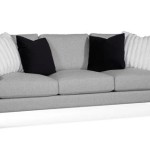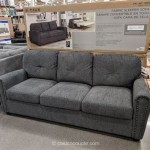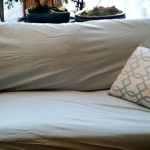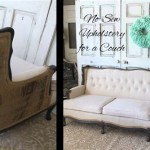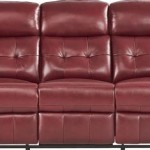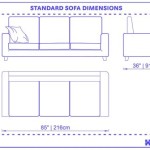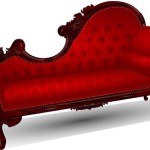The Difference Between Sofa, Couch, and Divan
The terms "sofa," "couch," and "divan" are often used interchangeably to describe a piece of upholstered furniture designed for seating multiple people. However, subtle differences in their historical origins, construction, and cultural connotations distinguish these terms. Understanding these nuances can be helpful when selecting furniture and discussing interior design.
Origins and Etymology
The word "sofa" originates from the Arabic word "suffah," referring to a raised platform covered with cushions and carpets used for sitting. This reflects the sofa's historical association with luxury and formality. "Couch," derived from the Old French word "coucher," meaning "to lie down," suggests a piece of furniture primarily intended for reclining or resting. "Divan" shares its roots with the Persian word "diwan," originally signifying a council chamber or a collection of writings. Over time, the term evolved to describe the low seating platforms used in these chambers, eventually leading to its current usage.
Structural Differences
While the lines between these furniture types have blurred, some structural distinctions can sometimes be observed. Sofas are traditionally characterized by their formal structure, featuring a fixed back and arms, and often including decorative elements like rolled arms or carved legs. They are typically designed to accommodate two or more people. Couches tend to be less formal and may feature a looser, more relaxed structure. They may have lower backs and less pronounced arms, prioritizing comfort and casual lounging. Divans, in their truest form, are upholstered, backless, and armless seating platforms, sometimes incorporating a mattress-like base. However, in contemporary usage, the term "divan" frequently refers to a type of sofa bed that includes storage space beneath the seating area.
Cultural Connotations and Usage
The preferred term for this type of furniture often varies depending on regional dialects and cultural contexts. In North America, "couch" is the most common term used in everyday conversation, while "sofa" is often reserved for more formal settings or higher-end furniture. In British English, "sofa" and "settee" are more prevalent, with "couch" used less frequently. "Divan" retains its original meaning in some cultures, referring to a council or assembly. In other contexts, it has evolved to describe a specific type of sofa bed with storage, as mentioned previously.
Modern Interpretations and Hybrid Designs
In the modern furniture market, the distinctions between sofas, couches, and divans have become increasingly fluid. Manufacturers often use the terms interchangeably, and many furniture pieces incorporate elements from multiple categories. For instance, a "sectional sofa" might combine the formal appearance of a sofa with the modular flexibility and casual comfort associated with a couch. Similarly, a "sofa bed" may incorporate the storage functionality traditionally associated with a divan. These hybrid designs reflect the evolving needs and preferences of consumers, prioritizing versatility and multi-functionality.
Upholstery and Materials
The materials used in the construction and upholstery of these furniture pieces can vary widely, contributing to their perceived formality and comfort. Sofas, particularly those intended for formal settings, might feature luxurious fabrics like velvet, silk, or high-quality leather. Couches, designed for more casual use, might be upholstered in durable, easy-to-clean fabrics like microfiber or cotton blends. Divans, especially those incorporating a bed mechanism, often utilize sturdy, supportive fabrics suitable for frequent use and easy conversion.
Placement and Function in Interior Design
The choice between a sofa, couch, or divan can significantly impact the overall aesthetic and functionality of a room. A formal sofa can serve as a focal point in a living room, creating an elegant and sophisticated atmosphere. A comfortable couch promotes relaxation and casual interaction in a family room or den. A divan, with its storage capabilities, can be a practical solution for smaller spaces or guest rooms, providing both seating and sleeping accommodations. The placement and arrangement of these furniture pieces contribute to the flow and usability of the space.
Size and Configuration
Sofas, couches, and divans are available in a wide range of sizes and configurations to suit diverse needs and spaces. From compact loveseats designed for two people to expansive sectional sofas that can accommodate large gatherings, the options are vast. Consider the available space, the intended use of the furniture, and the number of people it needs to accommodate when selecting the appropriate size and configuration.
Price Points and Quality
The price range for sofas, couches, and divans varies considerably depending on factors such as brand, materials, construction, and features. High-end sofas crafted from premium materials and featuring intricate detailing can command substantial prices. More affordable options using synthetic fabrics and simpler construction are readily available. Consider budget constraints and desired quality when making a purchase decision.

Sofa Vs Couch Which One Is Better Love My Beds

Faq What S The Difference Between A Sofa And Couch Wfmo

What Is A Divan

Faq What S The Difference Between A Sofa And Couch Wfmo

What S The Difference Between A Chaise Divan Daybed Settee

What Is A Divan

Sofa Or Couch Quick And Dirty Tips

Sofa Couch Or Divan

What Is A Divan

Chaise Divan Daybed Settee What S The Difference

